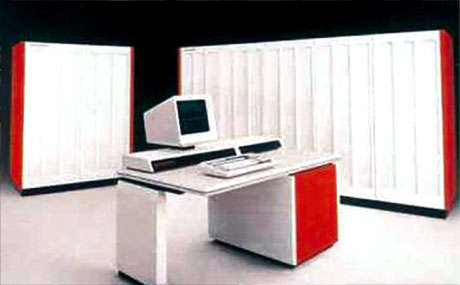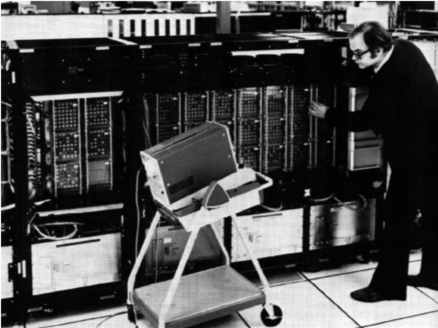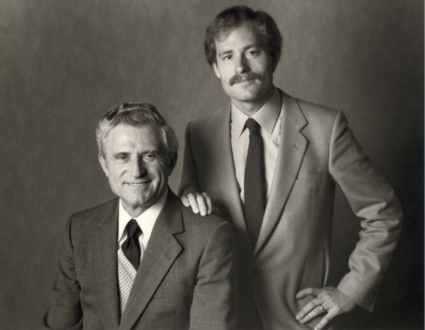| Gene Amdahl |
| Written by Harry Fairhead | |||||||
Page 3 of 3
First LSI-based mainframeThe key to his success was the use of Large Scale Integration (LSI) well before other companies realised the potential of the technology. Amdahl Corporation spent over $40 million on research and development before delivering its first machine, a 1Mbyte system with 16 I/O channels that was priced at $3.65 million but was a bargain in that it outperformed the current IBM 360 range and the latest 370 processors.
The 470 V/6
In late 1975 Amdahl announced the first LSI-based mainframe, the 470 V/6. The use of LSI chips had reduced its size to a quarter of equivalent machines and it was three times more powerful than the IBM model at the same price. Large companies decided this was too good to ignore and ordered it in quantity. At the start of 1977 Amdahl Corporation had sold fifty and was making a large profit.
An Amdahl 470V6 under final test
IBM couldn’t maintain its pricing policy in the light of the 470 and started to produce faster machines for less money. Amdahl kept up the pressure, matching each new machine that IBM produced with a faster and cheaper model. This was the start of the power/price revolution that eventually resulted in the PC on our desktops. However, in the end IBM started to win the race and Amdahl sold much of his stock to Fujitsu, who still run the company today. Trilogy And WSIWith the cash he got from selling Amdahl Corporation he started another company - Trilogy - along with his son and the former Amdahl chief financial officer. Such was the power of the Amdahl reputation that Trilogy was able to raise a huge amount of capital, $85 million, to go into the business of building large fast computers.
Gene Amdahl and son Carl at the founding of Trilogy 1981
Trilogy was in direct competition with both IBM and Amdahl Corporation. His idea this time was to push LSI forward to the logical limit of building the whole computer on a chip. Very reasonable, but at the time the number of transistors that you could squash into a given area wasn’t very high and it need an entire 2.5 inch wafer to build anything useful. Amdahl coined the term “Wafer-Scale Integration”, WSI, and reckoned that it would take only twenty such wafers to build his entire machine. He planned a machine that would be far more powerful than any of the IBM or Amdahl Corporation mainframes and he would sell it for only $4 million. He was so sure that it could be done that he claimed that he would have a sales of $1 billion only two years after the machine was launched. On the basis of these ideas and promises, Trilogy eventually raised $230 million, making it the world's largest start-up company. As it turned out WSI was much more difficult than he imagined. The small size of the wafers forced him to split the arithmetic unit across two wafers and this caused intercommunication difficulties which slowed the whole processor down. There were production problems with metal alloy connections that short circuited. At the start of 1985 it was clear that no computer was going to be ready before 1987, three years later than he had promised. That summer he was forced to give up any idea of building a computer but he still planned to build WSI chips. Then in 1985 Trilogy merged with a company called Elxsi, which was also trying to build a supercomputer. Together they shifted their attention to competing with DEC by producing a super VAX compatible machine. Amdahl left Elxsi in 1989, having already founded his next venture, Andor International, in 1987. In 1996 he co-founded Commercial Data Servers later rebranded as Xbridge Systems again developing mainframe-like machines but this time with new super-cooled processor designs and aimed at physically smaller systems. One such machine, from 1997, was the ESP/490 (Enterprise Server Platform/490), an enhancement of IBM's P/390 and in 2004, Amdahl was appointed to the Board of Advisors of Massively Parallel Technologies. Amdahl’s attempts at wafer integration were never successful. At the time, such was the attraction of the idea that others tried it - including Clive Sinclair in the UK- but to my knowledge it was never a workable system. Instead of getting bigger, integrated circuits got denser and WSI was sidelined by Very Large Scale Integration, or VLSI, which is the technology used to build microprocessors and microcomputers. The days of the million dollar computer were well and truly over. This didn’t mean that electronic engineers couldn’t make millions of dollars by designing them but they would have to do it by selling millions of them! Amdahl's LawIf you think of laws that have been invented by hardware people you probably think of Moore's law that the number of transistors on a chip doubles every 18 months or so - this, of course isn't a law. Amdahl on the other hand has a proper law named after him. Amdahl was very interested in making hardware go faster and one obvious way to do this is to create parallel processes. The big problem is, as Amdahl found, the need to allow for processes which are inescapably sequential. Amdahl's law is: The speed up you get from using n processors is:
where B is the fraction of the program that is forced to be executed serially. That is, if you use n processors the job will be done in a fraction S of the time it takes one processor. Not a very deep law, but one that is worth knowing as it gives you an idea of how much hardware to throw at a problem to get a reasonable return.
More InformationAn Interview with Gene M Amdahl (2007) Related ArticlesThomas J Watson Jr and the IBM 360 Birth of the Intel 4004 - the First Microprocessor John Backus - the Father of Fortran
To be informed about new articles on I Programmer, sign up for our weekly newsletter, subscribe to the RSS feed and follow us on Twitter, Facebook or Linkedin.
Comments
or email your comment to: comments@i-programmer.info <ASIN:0471736171> <ASIN:1403315175> <ASIN:007136207X> |
|||||||
| Last Updated ( Saturday, 03 September 2022 ) |




